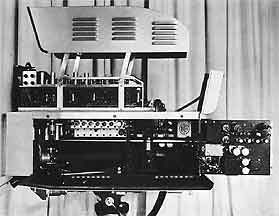 |
|
The first color television camera: description, photos, video clips
thanks for the contributions to this page - several TK-41 operators from "the good old days" submitted photos from their personal scrapbooks |
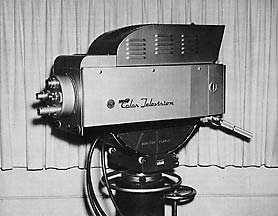 |
The TK-40 and its modified successor, the TK-41, were the first television cameras able to broadcast live color images. Beginning with the "Colgate Comedy Hour" on 11/22/53 these camera were in wide use at TV network and affiliate studios, as well as independent TV production facilities through the 1960's.
From the RCA TK-40A service manual printed in 1954, here's a description of RCA's first color camera: |
|
The RCA Color Camera (MI-40500) is a live pick-up camera used to separate a color image into its primary red, blue, and green component images and convert them to signals required for the RCA color television system. (Webmaster note: the RCA color system became known as the NTSC system. Introduced in 1953, it is the system still in use in the U.S.A. It will become obsolete as digital broadcasting completely replaces NTSC transmissions in 2007).
The color camera contains a light splitting system, three image orthicon tubes, horizontal and vertical deflection circuits, target blanking circuit, high voltage circuit, image orthicon protection circuit, and three video preamplifier circuits, one for each of the three color channels. The power and signal voltages are conveyed to and from the camera by means of three standard 24 conductor camera cables. The cables are attached through connectors located under and to the rear of the camera housing base plate. Filament voltages are supplied from two transformers housed in the camera. Each transformer is adequately fused. Control handles project from the rear of the camera. These handles are used for the control of panning and tilting motions of the camera. The handle on the right is also used for focusing the camera optical system. |
|
|
|
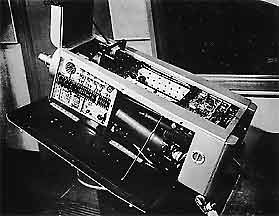 |
|
A hinged hood ahead of the viewfinder on the top of the camera housing offers accessibility to parts of the optical system. The camera filament transformers, elapsed time indicator, and the viewfinder power and signal terminal connections are also accessible beneath this hood. The side door panels of the camera housing swing outward making all components readily accessible for servicing. Two sets of communication and program sound jacks are mounted on a strip installed below the back (operating) panel of the camera. They provide a means of setting up communications between the camera operator, dolly operator, camera control operator, and the program director, etc. The utility outlets and a fuse are mounted on the under side of the back end of the camera. They provide facilities for an independent source of ac that may be used for test equipment when the camera voltages are turned off. Two tally lights are mounted on the front face of the camera. These lights serve to indicate to the actors when the camera is in actual use. In addition, there is one tally on top of the viewfinder for directors and one on the kinescope bezel plate for the operator. The latter are operative, however, only when used in conjunction with a camera switching unit. These lights are normally off until a tally relay is activated by a control voltage (24 volts dc). The individual image orthicon tubes and the area within the camera housing are air cooled. All external areas of the camera and viewfinder which are subject to absorption of radiant heat energy have an an aluminum finish to further aid in maintaining optimum temperature conditions within the camera. OPTICAL SYSTEM MECHANICAL SPECIFICATIONS (Webmaster note: racks of control equipment were located in a remote control room where color and brightness adjustments were constantly monitored and adjusted by a Video Control operator). |
|
| See a video clip from NBC's "Wide Wide World" showing TK-41's at KMTV-TV - Omaha, Nebraska - September 1957
(Quicktime Player version 6 or later required) |
|
|
|
|
| See a video clip from NBC's "Wide Wide World" showing TK-41's at NBC's Color City Studios in Burbank, California - September 1957
(Quicktime Player version 6 or later required) |
|
|
|
|
| See a video of early color TV clips edited to the soundtrack of a circa 1951-52 RCA color TV demo to the FCC
(Quicktime Player version 6 or later required) |
|
|
|
|
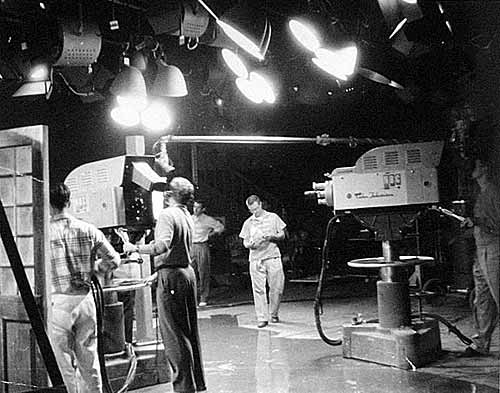 Behind the scenes at "Matinee Theater" - NBC Color City Studio 4 - Burbank, CA |
|
|
|
|
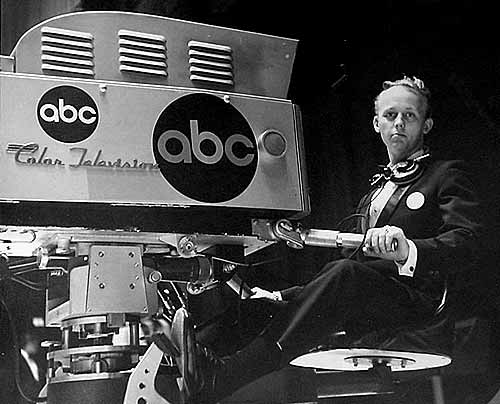 Dale Walsh flying a TK-41C on a crane for ABC-Hollywood in the 1960's |
|
|
|
|
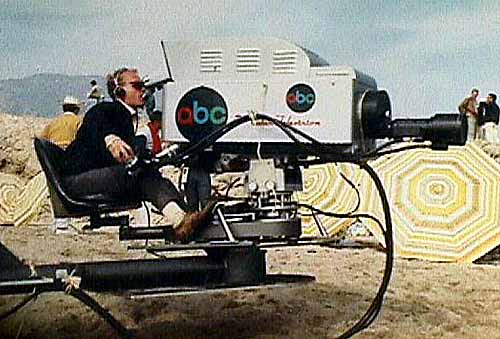 Dale Walsh shooting for ABC Sports on Venice Beach, late 1960's. Dale looks pretty comfy on that crane don't you think? |
|
|
|
|
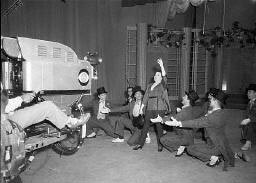 |
Judy Garland makes her television debut from Television City in Hollywood September 23rd in a rare live CBS color show, "Ford Star Jubilee," doing the same review she did in the New York Palace Theatre and the London Palladium. She insisted on a live audience. |
|
|
|
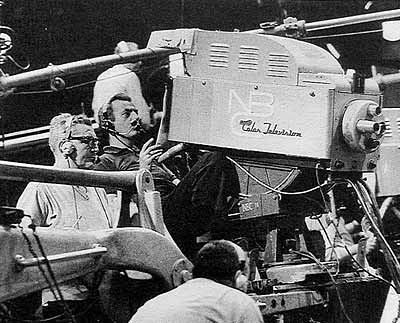 |
TK-41 during 1960's Hallmark Hall of Fame production at NBC studios in New York. Note the kludged viewfinder hood. It is quite common to see the stock RCA-supplied viewfinder snout either removed or replaced by a different hood more to the liking of the camera operator. |
|
|
|
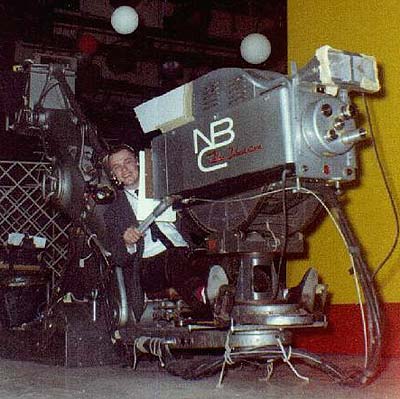 |
Jan Kasoff at NBC's Brooklyn, New York studios, 1960's. Note the cardboard viewfinder hood attached with masking tape. Obviously, NBC operators weren't fond of RCA's stock viewfinder snout! Also, supplemental fill lights are attached to the front of the camera. Lights similar to these are still in use today to add sparkle to the eyes and fill in facial wrinkles. |
|
|
|
 |
Dean Martin at NBC Color City circa late 1960's Burbank, California |
|
|
|
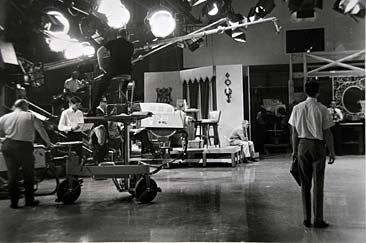 |
On the set of "The Dean Martin Show" Studio 4 - NBC Color City, 1965 Burbank, California (photo taken by Bruce Bonnett) |
|
|
|
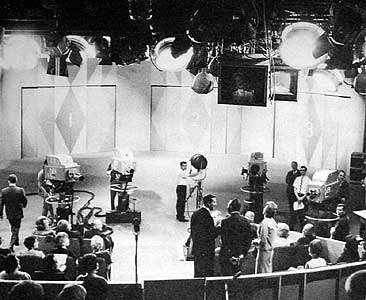 |
Let's Make a Deal with Monty Hall
NBC Color City - Burbank, California |
|
|
|
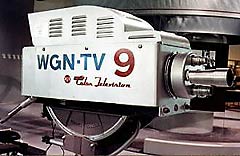 |
TK-41 formerly in service at WGN-TV on display at the Museum of Broadcast Communication, Chicago, Illinois |
|
|
|
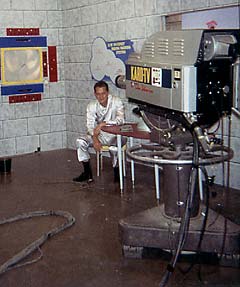 |
TK-41 on the set of "Major Astro," an afternoon children's program at NBC affiliate KARD-TV, Wichita, Kansas. My snapshot was taken in 1964. |
|
|
|
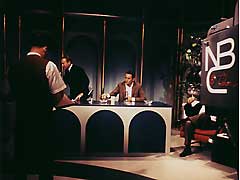 |
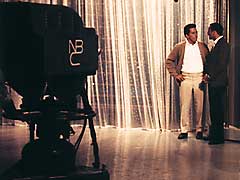 |
|
"The Tonight Show" 1963 (with substitute host Joey Bishop and guest Andy Williams)
|
|
|
|
|
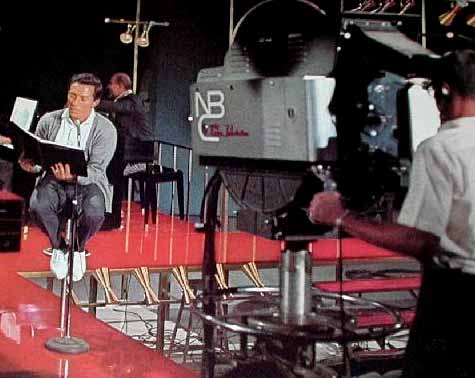 "The Andy Williams Show" in 1963 at NBC Color City - Burbank, California |
|
|
|
|
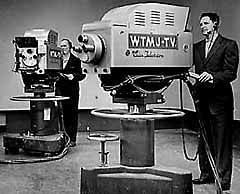 TK-40A cameras colorcasting at WTMJ-TV, Milwaukee, Wisconsin |
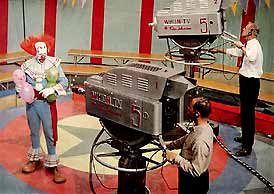 "Bozo the Clown" at WHDH-TV, Boston |
|
|
|
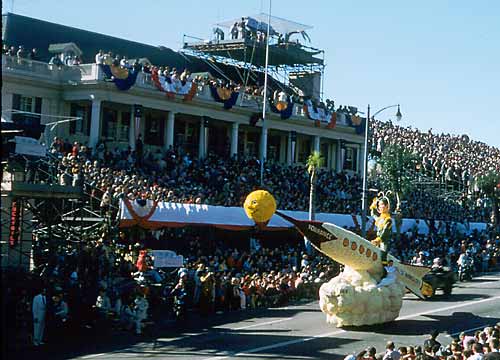 TK-41's colorcasting the Tournament of Roses Parade - Pasadena, California - January 1, 1958 There are at least four TK-41's in this photo. The cameras on the upper platform have NBC chimes logos on them, however the two TK-41's on street level do not have NBC logos - these are probably KTLA, Channel 5's cameras - KTLA began colorcasting the Rose Parade in 1955. |
|
|
|
|
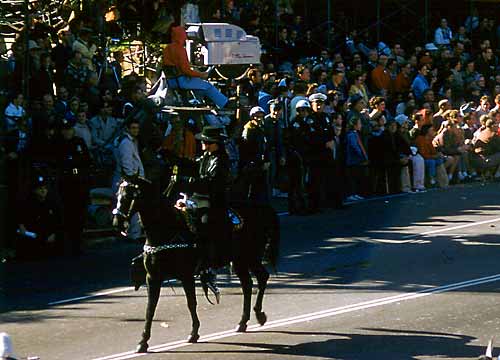 Another photo from the Rose Parade - January 1, 1958 This is probably a KTLA, Channel 5 camera |
|
|
|
|
|
click to see more photos of RCA TK-40/41 Color television cameras in action
|
||
|
|
||
|
|
